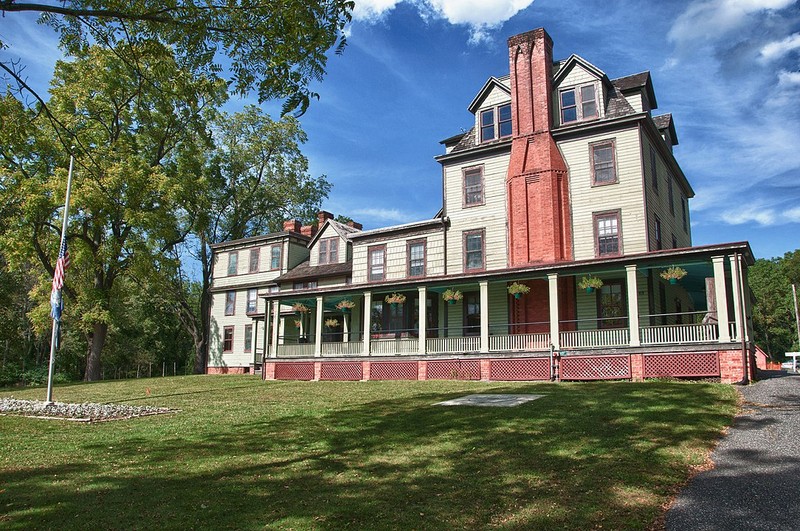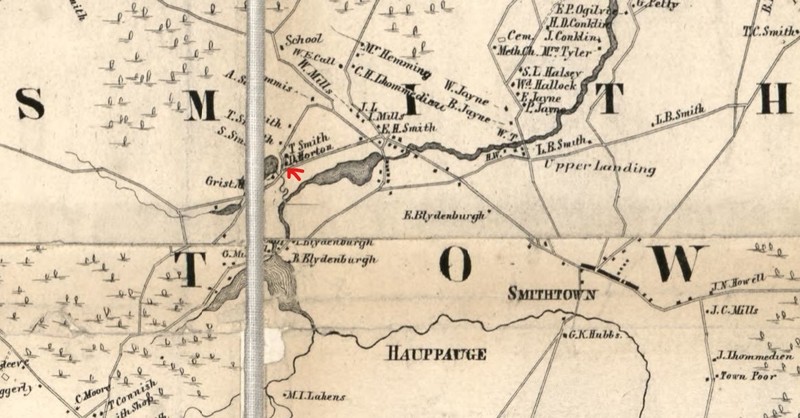Caleb Smith House Museum in Caleb Smith State Park Preserve
Introduction
Text-to-speech Audio
Images
2012 photo of Wyandach Clubhouse/ Caleb Smith House (AJW1188)

Caleb Smith House (red arrow) and Smithtown vicinity on 1858 map of Suffolk County (Robert P. Smith)

Backstory and Context
Text-to-speech Audio
Caleb Smith I (1724-1800) was the great-grandson of the founder of Smithtown, Richard "Bull" Smith (sometimes spelled Smythe), who died [d.] in 1692. Richard Smith was given a land patent for what became Smithtown by Richard Nicholls, Colonial Governor, acting on behalf of the Duke of York. In his will, Richard Smith left land to his six sons and two daughters; his son, Daniel [Sr., grandfather of Caleb; d. 1715] received the other half of the pasture south of his house, the westward part of it, and an equal share of land divided among all of his siblings. Richard Smith wished for all of James Neck to be kept in the family forever through his six sons.
Caleb Smith married Martha Smith (not related) in 1755; the couple had four children. Both Caleb Smith and his father, Daniel Smith Jr. (1691-1763), owned slaves in the 1750s; Caleb owned one male enslaved person and Daniel Jr. owned one female. Of the 92 heads of families in Smithtown counted in 1776, 29 had a last name of Smith. Other common surnames in the town of 555 were Mills and Blydenburgh. After Caleb's death, the house passed to his son, Paul Theodore (1759-1813), and then to Paul T.'s son, Theodorus (1795-1876).
The Caleb Smith House began as a two-story farmhouse and has been expanded several times since then by the gun club, but most of the original house survives, with new additions to the east and west. Caleb's initials were found inscribed in a brick in the chimney of the original portion of the house ("C S 1752"). The Brooklyn Rod and Gun Club was established in 1872. They purchased the Caleb Smith House, that had been passed on from father to son for multiple generations, in the 1880s. The club changed their name in 1893 to the Wyandanch Sportsmen's Club, after a sachem from the Nesaquakes who ruled 13 Native American tribes on Long Island. The property beyond the expanded farmhouse-turned-clubhouse was used by the club for fly fishing and bird hunting. New York State purchased the club's property in 1963 and added another 109 acres near the headwaters of the river in 1974. New York State opened the property as a park on April 1st 1974, originally calling it Nissequogue River State Park. Two branches of the river run through the park.
The park includes a Blacksmith shop and an historic barn built around 1790 with a hewn mortise and tenon frame plus several additions. Other historic homes are within the park and are currently used as residences. The houses were built on former parts of the Smith estate that were sold off; the Brooklyn Rod and Gun Club bought back the properties. The Caleb Smith House and the historic buildings are part of the New York and National Register-listed Wyandanch Club Historic District, on the northwest side of Jericho Turnpike.
While there is no charge for entry into the Caleb Smith House Museum, there is a fee to enter the park, and additional fees for some activities (see the link below). At the end of May, entrance fees go into effect any day the park is open. After Labor Day, park entrance fees will only be charged on weekends.
Sources
Egan, Rita J. Smithtown, A History: The Homes of Caleb Smith State Park Preserve, Patch, Smithtown, NY. April 24th 2011. Accessed April 9th 2021. https://patch.com/new-york/smithtown/smithtown-a-history-the-homes-of-caleb-smith-state-pa255bb13125.
Ganz, Charlotte. Building-Structure Inventory Form, Headquarters & Office, Nissequogue River State Park, Smithtown, NY. Albany, NY. NY State Historic Trust, 1972.
Ganz, Charlotte. Historic and Natural Districts Inventory Form, Nissequogue River State Park (Wyandanch Club), Smithtown, NY. Albany, NY. NY State Historic Trust, 1975.
O'Callaghan, Edmund Bailey. M.D. The Documentary History of the State of New York. Volume III. Albany, NY. Weed, Parsons & Co., 1850.
Ross, Peter. Pelletreau, William Smith. A History of Long Island From Its Earliest Settlement to the Present Time. Volume 2. New York, NY. Lewis Publishing Company, 1905.
Ruppenstein, Andrew. Caleb Smith House, Historical Marker Database. November 27th 2018. Accessed April 6th 2021. https://www.hmdb.org/m.asp?m=126831.
Ward, Simeon. Werner, Charles J., ed. A History of Hauppauge, Long Island, N.Y.. New York, NY. Charles J. Werner, 1920.
https://en.wikipedia.org/wiki/Caleb_Smith_State_Park_Preserve#/media/File:Wyandanch_Club.jpg
Library of Congress: xx[url]
